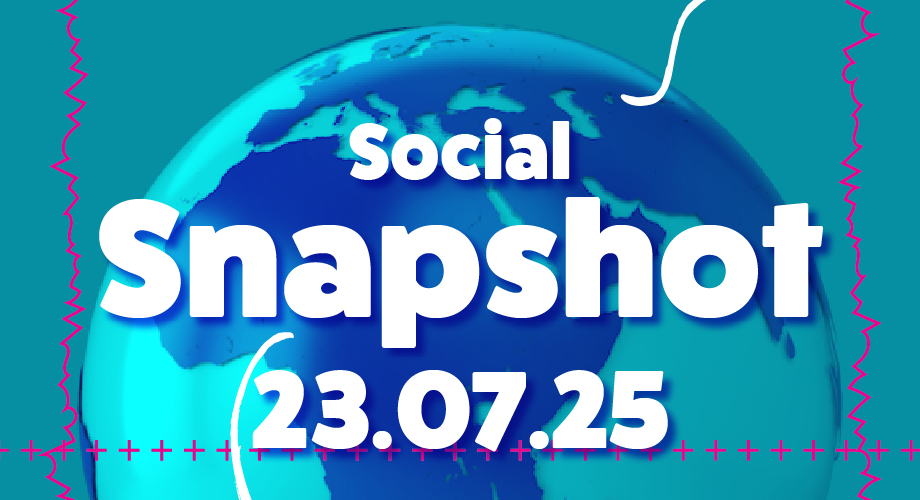July 23, 2025

It feels like these snapshots are always about algorithm changes that surprise everyone or some kind of new AI development with these platforms…so, quite refreshingly, we’re not going to cover any of that this week!
Instagram gets your likes in order
This post from a LinkedIn user last week surprised a few!
While not rolled out on a wider scale yet, Instagram is helping to break down carousel likes so you can find who liked which picture and when! This is great for those who love to post series of pictures and wonder which enamoured their following most. It’s common to want to put the best up front first, and perhaps that will reflect in the data longer term – the likes will drop as the carousel moves along – much like video views drop off.
It’s another level of granular performance data – and this is always welcome.
We talk a lot about hooks in social – so the first slide on a carousel is of course vital…
“Should I use the one of me looking out to sea? Or the one of me sipping a cocktail?”
For personal use, food for thought – but for brands, what does this mean? The aim is always about effective storytelling – keeping the clicks rolling. So, whether it’s food brands using recipes or a B2B business explaining cloud AI adoption (ah damn, we said we wouldn’t mention AI), the possibilities for measuring and now repurposing are endless.
Turn that most engaged carousel image into a standalone static – or animate it for something more eye-catching!
Auto-scroll on the rise
Elsewhere on Instagram, the Meta platform appears to be following in the footsteps of TikTok and YouTube with a potential auto-scroll feature. Currently in testing, users can click the three dots on a post and it enables an auto-scroll.
A more laid-back, easier-to-digest user experience? Or a doom-scrolling trap?
Many will find good use of it, and that it’s optional is a bonus for those who prefer classic. But this does smack of another way of helping users see more ads as well. More ad visibility + better performance metrics for campaigns = more money spent with Meta.
Sure, we’re a bit cynical here – but an open mind is always best, we say!
Snapchat stands tall
To some degree, Snapchat has become the forgotten child among the big social media family. But it still boasts one of the strongest ROAS in comparison to other channels.
They themselves profess, via a study from Triple Whale, that ‘despite being a smaller platform by spend share, Snapchat achieved a 7.5% ROAS improvement while most platforms declined. And, for this cohort of advertisers, Snapchat had the lowest CPA across all platforms.’
According to Statista, Snapchat’s user base rose to 23.67 million in the UK in 2024. It’s climbing at about 1.5m users per year.
The demographics are dominated by young adults and teenagers – leaning towards females more so in both segments. And despite having a low overall usage base compared to other social platforms, the data on ad performance is pretty remarkable.
Why is it winning? Hard to draw proper conclusions on this but the augmented reality element is certainly getting a pull. It’s no longer about just creating hilarious filters, with brands putting their creative in the mix.
Virtual try-on experiences have driven massive sales. In-store AR is giving customers a new way to experience their brands. TV shows are adopting filters for brand awareness and big players in the consumer market are showing off their in-store experiences to bring customers IN store rather than just shopping online.
It’s very clear and it’s working so well for the younger demographic who are valuing experiences as much as they are product quality.
LinkedIn flip-flopping
This article in mediaweek alerts us that LinkedIn is rolling back feed changes that show posts from weeks ago. This is in response to users telling LinkedIn they weren’t happy with seeing older content – so, they’ve reverted their algorithm (damn, that’s twice) back to the old format.
A now deleted LinkedIn post from Bhairavi Jhaveri at LinkedIn explained that the change in algorithm was experimental – and clearly it hasn’t quite worked, but it’s good they’ve responded to feedback (Meta, take note).
In fact, if you go onto your LinkedIn feed now you can sort by ‘recent’ or ‘top’ – so you still have the option of seeing the most recent posts from your network, or the most likely to appeal to you – as deemed by LinkedIn.
That’s it for this week. Any thoughts? Let us know!